|
Size: 345
Comment:
|
Size: 3893
Comment:
|
| Deletions are marked like this. | Additions are marked like this. |
| Line 1: | Line 1: |
| = Tomografia de Muões - Cronologia = <Em construção> |
= MUON TOMOGRAPHY - TIMELINE = /!\ UNDER MAINTENANCE /!\ |
| Line 4: | Line 4: |
| (Está página irá conter uma cronologia de acontecimentos importantes e trabalhos de referência na área da tomografia de muões) | (This page will contain a timeline of important events and reference works in the area of muon tomography) |
| Line 8: | Line 8: |
| '''Descoberta dos Raios Cósmicos''' | {{attachment:1_2.png}} '''Cosmic Rays Discovery'''<<BR>> Austrian physicist Victor F. Hess discovers cosmic-rays in a series of ascents in a hot-air balloon while looking for the source of the ionization radiation observed in the ground and in the atmosphere. His highest ascent was at 5.3 km of altitude. <<BR>> == 1936 == {{attachment:2.png}} '''Muon Discovery'''<<BR>> American physicist Carl D. Anderson and his graduate student Seth Neddermeyer discovered the existence of muon particles. The first observation of a muon was in a cosmic-ray. |
| Line 12: | Line 15: |
| == 1936 == '''Descoberta do Muão''' |
== 1955 == {{attachment:3.png}} '''First Use of Muons'''<<BR>> First reported use of cosmic-ray muons by Eric George to measure the ice thickness above a tunnel in Australia. The work used spark chambers to detect the muons |
| Line 17: | Line 20: |
| === 1912 === ==== 1912 ==== |
== 1967 == {{attachment:4.png}} '''Muon Radiography in Chephren Pyramid'''<<BR>> Muon radiography is used by Luis Alvarez team to look for hidden chambers in Chephren Pyramid in Egypt. The detection was made with spark chambers and scintillation counters. No additional chambers were found at that time. <<BR>> == 1987 == {{attachment:5.png}} '''Measurement Depth of Nagoya Subway Tunnels'''<<BR>> Minato ''et al''. measured the depths of Nagoya subway tunnels using cosmic-ray muons. The detectors used were based in scintillation counters. <<BR>> == 1999 == {{attachment:6.png}} '''Moon Shadow is Imaged using Muons'''<<BR>> At the Soudan II detector in Minnesota, using drift tubes and at an undergroud depth of 700m, the Moon shadow is imaged using muon flux. <<BR>> == 2003 == {{attachment:7.png}} '''Preparation to Inspect the Pyramid of the Sun'''<<BR>> The preparations on a muon detector system are iniciated to inspect the interior of the Pyramid of the Sun in Mexico. Some of the detection system uses scintillation counters. <<BR>> {{attachment:8.png}} '''Beginning Applications of Muon Scattering Tomography'''<<BR>> At LANL, a seminal work on utilising Coulomb scattering of muons to identify high-Z objects is made aiming the detection of nuclear treats. <<BR>> == 2007 == {{attachment:9.png}} '''Density Measurement of Mt. Asama'''<<BR>> Muography is used by Tanaka ''et al''. to measure a density profile of Mt. Asama and the 1944 Usu lava dome, both in Japan. The method used is based in emulsion cloud chambers. <<BR>> == 2008 == '''(Legnato National Laboratory Simulation and Prototype)''' == 2009 == {{attachment:10.png}} '''INFN Muon Tomography System'''<<BR>> The large-volume muon tomography system, built by INFN, demonstrates the possibility of material discrimination. The system is based on drift chambers. <<BR>> {{attachment:11_2.png}} '''Density Profile of a Volcano Interior'''<<BR>> The density profile of the interior of a volcano in Japan is imaged with cosmic-ray muography combined with classical gravimetry by Okudo and Tanaka. <<BR>> == 2010 == '''Puy de Dôme Vulcan Struture Study''' <<BR>> == 2012 == {{attachment:12.png}} '''Fukushima-Daiichi Plant Interior Simulation''' <<BR>> Simulation studies show the feasibility of identifying voids and movements of the material inside the reactor core at the stricken Fukushima-Daiichi plant. <<BR>> == 2014 == {{attachment:13.png}} '''Palazzo della Loggia Monitorization'''<<BR>> A monitorization system based in muon tomography is installed at Palazzo della Loggia, in Italy, to monitor the integral stability of the building. <<BR>> == 2016 == '''Water Tower Experiment''' <<BR>> <<BR>> == 2017 == ''' Scan Pyramids Project - Cheops Pyramid New Chamber'''<<BR>> [[Projectos/MuonTomography/more_z|More Info]] <<BR>> |
MUON TOMOGRAPHY - TIMELINE
![]() UNDER MAINTENANCE
UNDER MAINTENANCE ![]()
(This page will contain a timeline of important events and reference works in the area of muon tomography)
1912
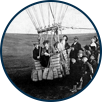 Cosmic Rays Discovery
Cosmic Rays Discovery
Austrian physicist Victor F. Hess discovers cosmic-rays in a series of ascents in a hot-air balloon while looking for the source of the ionization radiation observed in the ground and in the atmosphere. His highest ascent was at 5.3 km of altitude.
1936
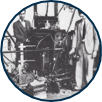 Muon Discovery
Muon Discovery
American physicist Carl D. Anderson and his graduate student Seth Neddermeyer discovered the existence of muon particles. The first observation of a muon was in a cosmic-ray.
1955
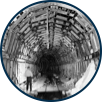 First Use of Muons
First Use of Muons
First reported use of cosmic-ray muons by Eric George to measure the ice thickness above a tunnel in Australia. The work used spark chambers to detect the muons
1967
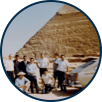 Muon Radiography in Chephren Pyramid
Muon Radiography in Chephren Pyramid
Muon radiography is used by Luis Alvarez team to look for hidden chambers in Chephren Pyramid in Egypt. The detection was made with spark chambers and scintillation counters. No additional chambers were found at that time.
1987
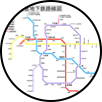 Measurement Depth of Nagoya Subway Tunnels
Measurement Depth of Nagoya Subway Tunnels
Minato et al. measured the depths of Nagoya subway tunnels using cosmic-ray muons. The detectors used were based in scintillation counters.
1999
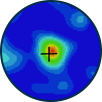 Moon Shadow is Imaged using Muons
Moon Shadow is Imaged using Muons
At the Soudan II detector in Minnesota, using drift tubes and at an undergroud depth of 700m, the Moon shadow is imaged using muon flux.
2003
 Preparation to Inspect the Pyramid of the Sun
Preparation to Inspect the Pyramid of the Sun
The preparations on a muon detector system are iniciated to inspect the interior of the Pyramid of the Sun in Mexico. Some of the detection system uses scintillation counters.
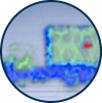 Beginning Applications of Muon Scattering Tomography
Beginning Applications of Muon Scattering Tomography
At LANL, a seminal work on utilising Coulomb scattering of muons to identify high-Z objects is made aiming the detection of nuclear treats.
2007
 Density Measurement of Mt. Asama
Density Measurement of Mt. Asama
Muography is used by Tanaka et al. to measure a density profile of Mt. Asama and the 1944 Usu lava dome, both in Japan. The method used is based in emulsion cloud chambers.
2008
(Legnato National Laboratory Simulation and Prototype)
2009
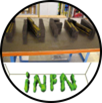 INFN Muon Tomography System
INFN Muon Tomography System
The large-volume muon tomography system, built by INFN, demonstrates the possibility of material discrimination. The system is based on drift chambers.
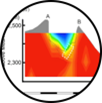 Density Profile of a Volcano Interior
Density Profile of a Volcano Interior
The density profile of the interior of a volcano in Japan is imaged with cosmic-ray muography combined with classical gravimetry by Okudo and Tanaka.
2010
Puy de Dôme Vulcan Struture Study
2012
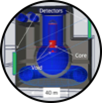 Fukushima-Daiichi Plant Interior Simulation
Fukushima-Daiichi Plant Interior Simulation
Simulation studies show the feasibility of identifying voids and movements of the material inside the reactor core at the stricken Fukushima-Daiichi plant.
2014
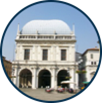 Palazzo della Loggia Monitorization
Palazzo della Loggia Monitorization
A monitorization system based in muon tomography is installed at Palazzo della Loggia, in Italy, to monitor the integral stability of the building.
2016
Water Tower Experiment
2017
Scan Pyramids Project - Cheops Pyramid New Chamber
More Info
